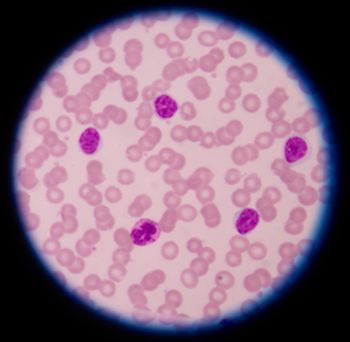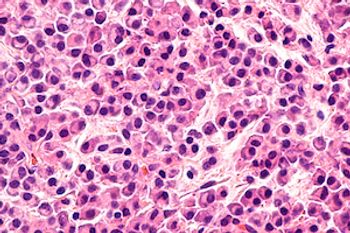
Oncology
Latest News

Latest Videos

CME Content
More News

New Jersey's largest payer will track a host of measures, including some that will evaluate the quality of end-of-life care.

We should try to remove barriers that are not only in place, but getting higher for clinicians and patients to get evidence-based care, said A. Mark Fendrick, MD, director of the Center for Value-Based Insurance Design at the University of Michigan.

Electronic health record (EHR)-based comorbidity assessment had low sensitivity for identifying major comorbidities and poorly predicted survival. EHR-based comorbidity data require validation prior to application to risk adjustment.

A study finds that protein markers may be a better predictor of drug response than genetic mutation are in patients with acute myeloid leukemia (AML). As a result, some patients who could benefit from treatment may not be eligible under current approval specifications.

Poor baseline Lung Immune Prognistic Index (combining derived neutrophils ratio greater than 3 and lactate dehydrogenase greater than upper limit of normal), or LIPI, was associated with worse outcomes for immune checkpoint inhibitor (ICI) treatment in patients with non-small cell lung cancer (NSCLC), but not with results of chemotherapy, according to a study in JAMA Oncology.

The language used by doctors contributes to why patients don't understand what they are told; the number of American adults without health insurance grew 1.3 percentage points from the end of 2016 to the end of 2017; women are increasingly faced with the decision between 2D and 3D mammograms.

The challenges that adolescents and young adults face before and after treatment are all unique to an individual patient, according to Julie Wolfson, MD, of the University of Alabama at Birmingham School of Medicine.

The approval expands the use of olaparib to include the treatment of patients with BRCA-mutated HER2-negative metastatic breast cancer. The FDA also expanded the approval of Myriad’s BRCAnalysis CDx, a companion diagnostic to olaparib, to include the detection of BRCA mutations.

It’s very unusual to see significant cost savings in the first year of a program; that was true of all the pioneer ACO programs, said Jeff Patton, MD, CEO of Tennessee Oncology.

More than half of octogenarians and nonagenarians with stage III non–small-cell lung cancer did not receive treatment, according to a study in CANCER. Older age, black race, and living in a lower educated census tract were found to be risk factors for not receiving treatment.

Involving providers in the development process of new reimbursement models increases the chance that the initiative will be successful and works against caregiver burnout, said Peter Aran, MD, medical director of Population Health Management at Blue Cross Blue Shield of Oklahoma.

AstraZeneca’s epidermal growth factor receptor (EGFR) inhibitor, osimertinib (Tagrisso), is on the fast track in 2018 to become a first-line treatment for adult patients with locally-advanced or metastatic non-small cell lung cancer (NSCLC) whose tumors have EGFR mutations.

Eisai’s multiple receptor tyrosine kinase inhibitor lenvatinib and Merck’s anti–PD-1 therapy pembrolizumab as a combination therapy for patients with renal cell carcinoma received the designation based on results from the renal cell carcinoma cohort in Study 111.

Don’t underestimate the power that it takes to make sure a value-based program is working, said Sarah Cevallos, chief revenue cycle officer, Florida Cancer Specialists.

A report from the American Cancer Society estimated new cancer cases and deaths for 2018 and took a look at the most recent data to determine cancer incidence through 2014 and mortality through 2015.

The healthcare triangle (patients, payers, and providers) begins with the patient, so we should include the patient in some of the decision-making, said Roger Brito, DO, national director for oncology, Aetna.

The approval will expand the currently approved indication for the prevention of skeletal-related events in patients with bone metastases from solid tumors to also include patients with multiple myeloma.

A subset of patients with chronic lymphocytic leukemia (CLL) with highly expressed CD49d have poorer outcomes while on Bruton’s tyrosine kinase (BTK) inhibitor ibrutinib, which antagonizes B-cell receptor (BCR) signals. However, a team of researchers may have found a way to treat these patients.

The fact that you have certain drugs that treat numerous cancers, and that they may treat 1 cancer different or better than another, would suggest that we should probably have differential pricing models, said A. Mark Fendrick, MD, director of the Center for Value-Based Insurance Design at the University of Michigan.

New drugs to treat multiple myeloma (MM) have provided clinical benefits, but a study published in the Journal of Managed Care & Specialty Pharmacy found not all of them can be considered cost effective.

New drugs to treat multiple myeloma (MM) have provided clinical benefits, but a study published in the Journal of Managed Care & Specialty Pharmacy found not all of them can be considered cost effective.

While chemotherapy with thoracic radiation has been established as the standard of care for the initial treatment of non-metastatic small-cell lung cancer, a large proportion of patients do not receive these treatments and in turn have lower overall survival, according to a study published in JAMA Oncology.

Coverage of our peer-reviewed research and news reporting in the healthcare and mainstream press.

Bo Gamble, director of Strategic Practice Initiatives at the Community Oncology Alliance (COA), believes that broadening communication and education is COA’s main goal in 2018.

Southwest Airlines has set up a split fill program, pharmacy benefit manager, health advocacy program, and a cancer resource guide for employees, said Judy Berger, senior manager, benefits planning, Southwest Airlines.























































